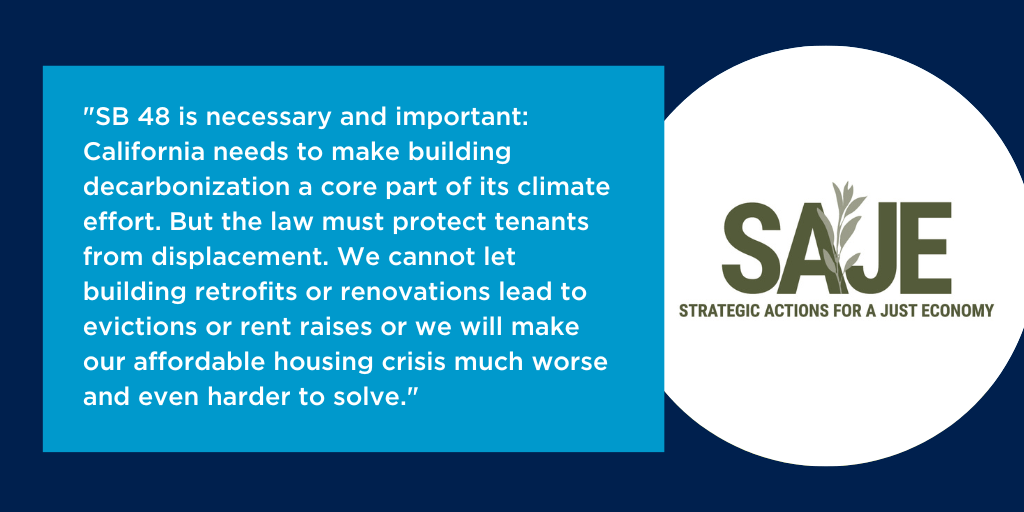
In a big step to bring significant resources to development of a statewide building performance standard (BPS) proposal, Gov. Newsom signed Senate Bill 48, the Building Energy Savings Act (SB 48) on October 7.
Authored by Sen. Josh Becker (D-Menlo Park) with IMT as one of two sponsors, the Act requires the California Energy Commission (CEC) to use the data from California’s existing building energy benchmarking and transparency law to develop a strategy to decarbonize California’s large existing buildings. Through its 2021 Integrated Energy Policy Report (IEPR), CEC has already called for California to adopt a statewide building performance standard. Four other states and eight U.S. localities have adopted BPS to date.
Sen. Becker chairs the subcommittee responsible for the budgets of California’s energy and environmental agencies, including CEC. He recently inserted an additional $10 million into CEC’s budget to strengthen implementation of the existing benchmarking law. CEC can now draw on a portion of that $10 million to begin implementation for SB 48.

What’s included in SB 48
The new law requires CEC to consult with stakeholders and sister agencies to develop the strategy for submission to the legislature.
Specifically, the Act requires that by July 1, 2026, CEC, “in consultation with the State Air Resources Board, Public Utilities Commission, and Department of Housing and Community Development, shall develop a strategy for using benchmarking data to track and manage the energy usage and emissions of greenhouse gases of covered buildings in order to achieve the state’s goals, targets, and standards related to energy usage and emissions of greenhouse gases of covered buildings, including both of the following targets:
(1) The annual targets for statewide energy efficiency savings and demand reduction established pursuant to subdivision (c) of Section 25310.
(2) The greenhouse gas emission reductions targets for the building sector established by the State Air Resources Board as part of achieving the economywide greenhouse gas emissions reductions required pursuant to the California Global Warming Solutions Act of 2006.”
Collaborating with communities in California
SB 48 also requires that CEC consult with a long list of affected stakeholders starting with “community-based organizations representing tenant advocacy, equity, and environmental justice concerns.”
And, it places several requirements on CEC’s strategy starting with: “Avoid increasing utility and rental cost burdens for, or causing evictions, harassment, or displacement of, tenants of covered buildings.”
In order to ensure equitable participation and input, the Act requires CEC to “contract with one or more organizations with experience representing under-resourced communities, low-income residential tenants, and small commercial tenants to advise the commission on the development of the strategy.”
If a contractor’s “recommendations are not adopted in the final strategy, [CEC shall] provide a written explanation of why the recommendations were not adopted and how the final strategy attempts to address the issues raised in those recommendations in an alternative way.”
Sen. Becker’s team and IMT worked with stakeholders including housing, racial justice, and tenant protection advocates, most notably Strategic Actions for a Just Economy (SAJE) to develop equity and tenant protection provisions, some of which, were unfortunately amended out of the bill by multiple committees. SAJE did not formally endorse the bill, but issued this statement:

SB 48 as introduced would have given CEC the authority to directly develop and enforce a BPS covering both energy and water. Despite our efforts, multiple committees trimmed the breadth and power of the bill, first removing water and then CEC’s authority to enforce a BPS without a new law giving CEC such authority.
For more detail on SAJE’s recommendations, check out this paper from September 2023 that details some learnings from the SB48 process: “Decarbonizing California Equitably: A Guide to Tenant Protections in Building Upgrades/Retrofits throughout the State.”
California’s next steps

CEC is the best resourced state energy office in the country, with a long track record of innovation including in developing California’s nation-leading building energy codes. And, California is ahead of the nation in solar energy penetration and in responding to that penetration and the resulting “duck curve” by focusing on time of use of electricity. I’m optimistic that CEC will bring its tremendous rigor and innovation to developing a detailed blueprint for a BPS that will serve as a national model not only for building decarbonization but for incentivizing buildings to shift the timing of their electric loads and thereby become an asset for electric grid reliability.
As we’ve seen in preceding jurisdictions, BPS are the most powerful policies for driving change in existing buildings. BPS attach financial consequences to building performance data, heightening the stakes for assuring accurate data. And, with the great power of BPS, comes great responsibility, including to minimize unintended consequences, protect housing affordability, and advance equity.
For many years, IMT has informally advised CEC, including related to California’s benchmarking law. IMT and CEC will step up our partnership as CEC consults with stakeholders and develops the new strategy required by SB 48.
